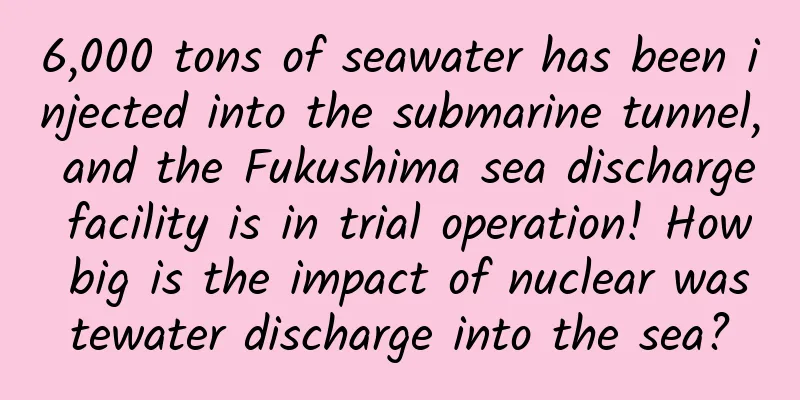6,000 tons of seawater has been injected into the submarine tunnel, and the Fukushima sea discharge facility is in trial operation! How big is the impact of nuclear wastewater discharge into the sea?

|
The equipment for discharging contaminated water from the Fukushima nuclear power plant in Japan has begun trial operation. The discharge of nuclear wastewater into the sea has been opposed by many countries. How is nuclear wastewater produced? What impact will it have on the ocean? Is there really no other solution except discharging it into the Pacific Ocean? Compiled by New Media Editor Wang Shan On June 11, #Japan suddenly claimed that nuclear wastewater was harmful to health# became the number one trending search Recently, experts from Pacific island countries suggested using nuclear wastewater to build concrete infrastructure. Japan opposed the proposal, saying that nuclear wastewater may cause the evaporation of radioactive tritium, which is harmful to the human body. Previously, Japan has always claimed that nuclear wastewater is harmless and can even be drunk. According to local media in Fukushima, Japan on June 9, Tokyo Electric Power Company announced that the land-based discharge facilities of the Fukushima Daiichi Nuclear Power Plant's nuclear contaminated water discharge project will be put into trial operation from the 12th. ▲ Buckets used to store nuclear waste water Tepco said that the trial operation period of the land discharge facility will last about two weeks, during which fresh water without radioactive substances will be mixed with seawater to test whether a fixed amount of water can be discharged into the sea, and to confirm whether the sea discharge operation can be stopped by the control device in an emergency. At present, the operation of injecting seawater into the undersea tunnel for discharging nuclear contaminated water has ended on June 6, with an injection volume of about 6,000 tons. This seawater will be used to dilute the nuclear sewage to be discharged. According to reports from many Japanese media, the discharge mechanism of the undersea tunnel is to transport the diluted nuclear contaminated water discharged from land to the drainage outlet at sea through the undersea tunnel. 1 How is nuclear waste produced? In the eyes of the general public, the generation of nuclear wastewater in a nuclear power plant built on the seashore is a normal product of power generation. But in fact, this is a "natural disaster" caused by earthquakes and human factors. The working principle of a nuclear power plant is that nuclear fuel made of uranium undergoes fission in the reactor and releases a large amount of heat energy; circulating cooling water under high pressure takes out the heat energy, generates steam in the steam generator, drives the generator to rotate, and thus generates electricity. Cooling water plays a very important role in the whole process. ▲Schematic diagram of water circuit treatment in nuclear power plants Under normal circumstances, nuclear power plants only produce burnt nuclear waste, not nuclear sewage. Taking a pressurized water reactor nuclear power plant as an example, the water in the first circuit is radioactive, and the second circuit absorbs the heat of the first circuit through the heat transfer tube to become water vapor, and the third circuit is used to cool the water in the second circuit. So the water in the third circuit is water, which is not radioactive. But the Fukushima nuclear power plant in Japan is a boiling water reactor, which means there is only one circuit. As long as one factor in the circuit is destroyed, the entire circuit will not be able to operate normally, which happened to Fukushima. ▲The tsunami destroyed the Fukushima nuclear power plant, which also caused a series of problems On March 11, 2011, a magnitude 9 earthquake occurred in the northeastern waters of Japan. Due to the severe vibration, the three units of the Fukushima Nuclear Power Plant were shut down urgently, but it takes time for the reactor to cool down. If the cooling system, that is, the cooling water in the furnace, is evaporated, the temperature of the core will continue to rise, causing "core meltdown". Although the nuclear power plant immediately started the backup diesel generator to maintain the operation of the cooling system, half an hour later, the power system was completely destroyed by the tsunami. At that time, Tepco and the Japanese government did not come up with a better solution for a while, and as a result, all four units exploded. In this way, in order to cool down the damaged nuclear reactor, Japan had to adopt the method of "water injection cooling", waiting for the reactor to cool down naturally to a safe state, and then completely seal and abandon the nuclear power plant. But in this way, the cooling water will be discharged with radioactive substances. 2 What will it bring to the ocean? Therefore, Japan began to discuss how to deal with more than 1 million tons of sewage. For Japan, where every inch of land is valuable, the option of burying it underground is "too costly". Since it cannot be buried, it is better to dump it. The Japanese government held a cabinet meeting on April 13, 2021 and officially decided to discharge nuclear sewage from the Fukushima nuclear power plant, which is harmful to the marine environment, into the ocean. This has attracted the attention of governments and public opinion around the world, including the Japanese public. 3 What impact will sewage containing radioactive substances have once it is discharged into the sea? According to the changes in ocean currents, the nuclear wastewater discharged from Fukushima will first go north to the Sea of Okhotsk, then turn east, and a considerable part will reach the east coast of the Pacific Ocean in the United States, and finally circulate throughout the entire North Pacific Ocean, affecting dozens of countries and regions along the coast. A calculation result from a German marine science research institute also shows that from the date of discharge, radioactive substances will spread to most of the Pacific Ocean within 57 days. Three years later, the United States and Canada will be affected by nuclear pollution. In less than ten years, the entire Pacific Ocean will become a terrifying "nuclear sea". For organisms in the ocean, the harm of nuclear pollution is also huge. Tokyo Electric Power Company, which was previously responsible for operating the Fukushima Daiichi Nuclear Power Plant, said that it would filter the contaminated water again, and at that time, only tritium would be present in the nuclear wastewater. ▲Software simulation shows that in less than ten years, the entire Pacific Ocean will become a terrifying "nuclear sea" But even if there is only tritium, it is a radioactive isotope of hydrogen that is difficult to separate from water. It will undergo beta decay and has a half-life of up to 12.43 years. In an interview, Professor Liu Entao of the School of Oceanography of China University of Geosciences emphasized that humans are at the top of the food chain pyramid, and radioactive elements enriched in seafood and other organisms will affect humans through the transmission of the food chain. "Long-term and large-scale consumption of radioactively contaminated seafood may cause the accumulation of radioactive substances in the body to exceed the allowable amount, causing diseases such as chronic radiation sickness, and causing damage to organs, endocrine system, nervous system, etc." Currently, 12 countries and regions have imposed import restrictions on Fukushima food. Due to concerns that nuclear wastewater may contaminate seafood, Korean consumers have purchased large quantities of salt and seafood, and retailers have also stockpiled goods due to concerns about supply shortages, resulting in rising seafood prices in South Korea. 4 Is tritium really less harmful to the human body? There are differences of opinion in the scientific community regarding tritium. Since the maximum energy of tritium is 18.6keV and the average energy is 5.7keV, the beta ray it emits has a weak penetrating ability, with a maximum range of 6μm in water and a maximum range of only 5mm in air, it is generally believed that tritium is unlikely to cause radiation to humans from the outside. Only when it enters the human body can it cause radiation damage to humans from the inside. This is also the view held by the Japanese government. However, the opposing party believes that there are survey reports showing that around nuclear power plants with high tritium emissions, the mortality rate of leukemia and its newborns is higher than in other areas. In addition, Professor Toshiyuki Mata of the University of Industrial Medicine in Japan injected 270MBq of tritium-contaminated water into the abdomen of mice in a mouse experiment, allowing the mice to receive low-dose radiation equivalent to 3Gy. The results showed that the TCR genetic genome mutation rate of mouse spleen cells increased compared with the control group. Therefore, if people drink or inhale tritium-contaminated water or gas, or eat tritium-contaminated organic matter accumulated in food, it is possible to cause radiation damage to the human body. 5 Is there any other way? Is there no other solution to the large amount of polluted cooling water except discharging it into the ocean? This is not the case. On the contrary, from a scientific point of view, there are many ways to dispose of nuclear waste. There are two ways to deal with high-level radioactive nuclear waste internationally. One is to directly put the spent nuclear fuel into large cans after processing and bury them deep underground. Countries with vast territories such as the United States, Russia, Canada, and Australia are currently doing this. The other is to drop metal cans filled with nuclear waste into the seabed 4,000 meters below the selected sea area. China's treatment of high-level radioactive waste is similar to the first method: first send the spent fuel to the disposal site for glass solidification, and then bury it in a layer at least 500 meters deep. Therefore, Japan can also solidify the water tanks filled with nuclear wastewater and bury them deep underground. Another option is to use hydrogen/steam release, which is to electrolyze the waste water into hydrogen and oxygen, or heat it at high temperature to turn it into water vapor, and then release it into the atmosphere. The Japanese government has proposed five plans to deal with nuclear contaminated water. All sectors of public opinion strongly oppose the Japanese government's plan to discharge wastewater into the sea. One of the reasons is that there are other ways to deal with nuclear contaminated water, and these other ways may be more effective and reduce pollution. At present, all the nuclear contaminated water from the Fukushima Daiichi Nuclear Power Plant is stored in storage tanks at the nuclear power plant. The Japanese government has previously proposed five plans on how to deal with the nuclear contaminated water: discharge it into the sea, discharge it into the atmosphere after turning it into water vapor, discharge it deep underground through underground pipes, electrolyze it, and solidify it and bury it underground. Among these five options, discharging nuclear contaminated water into the sea is the cheapest, which is estimated to cost 1.7 billion to 3.4 billion yen, or about 102 million to 203 million yuan; the most expensive method is to solidify it and bury it underground, and its cost is estimated to be dozens or even hundreds of times that of discharging it into the sea. 6 Expert analysis: Japan's insistence on pushing nuclear weapons into the sea will harm the world The Japanese government has repeatedly harped on the term "nuclear contaminated water", claiming that what it is discharging is "treated water" purified by a "multi-nuclide treatment system", and even equated the Fukushima nuclear contaminated water with the discharge water from nuclear power plants around the world under normal operation. In this regard, experts said that the Japanese government's attempt to "whitewash" the discharge of nuclear contaminated water into the sea will not succeed. CCTV News special commentator Su Xiaohui said: "The Japanese government is still pushing for the discharge of Fukushima nuclear contaminated water despite opposition from many parties. In this process, the Japanese government is constantly "whitewashing", but it is obvious that it has not achieved the expected results. The Japanese government previously asked its media and social groups not to use the term "nuclear contaminated water" anymore, but to use "nuclear waste water" and "treated water". This move is to divert attention, because "nuclear waste water" and "treated water" are discharged after the normal operation of nuclear power plants and meet the standards, while "nuclear contaminated water" is the product of a nuclear accident, which is basically equivalent to nuclear waste." According to the regulations of the United States and other relevant countries on the treatment of nuclear waste, nuclear waste cannot be discharged and can only be stored for a long time. The severity of the Fukushima nuclear power plant accident is equivalent to the nuclear accident at the Chernobyl nuclear power plant. There is no international practice to discharge nuclear contaminated water into the sea. The Japanese government cannot tolerate opposition voices at home and abroad, and is extremely selfish and irresponsible in going further and further on the wrong path. (Source: CCTV News Client, Weibo @CCTV.com, Science and Technology Daily, Communist Youth League Central Committee, Beijing Science and Technology News Agency, Global Times) |
>>: Spherical space city? Sunglasses? The life of future astronauts is full of strange things
Recommend
Space is also about "environmental protection"! Wooden satellites are expected to become space "cleaners"
Image source: Kyoto University Author: Huang Xian...
Google's secretive hardware team just lost three key members
After years of development, Apple has improved th...
Uncover the secret of Perfect Diary’s private domain conversion!
In the early days, Perfect Diary achieved phenome...
The "magic weapon" for weight loss, the sweat-inducing suit, will make you pay the "IQ tax"?
As the temperature gradually rises, many beauty l...
Technology Outlook 2025: The era of AI autonomy is coming, and trust is the key cornerstone
The new era of AI autonomy and the urgency of ent...
Soul advertising, Soul advertising forms
Although the top promotion platforms are now famo...
How to plan a successful event promotion?
I believe everyone is familiar with event promoti...
Why doesn’t the iPhone 6 have a sapphire screen?
An article recently published by foreign media di...
How can cash loan products effectively improve conversion rates under high traffic costs?
To improve conversion rate is to improve user exp...
Why do I still get lung cancer even though I don't smoke or drink? Pay attention, this type of lung cancer has already targeted women
Spot check! Name a group of people at high risk f...
Will Microsoft's "affair" with Qualcomm and Intel affect its status as the "first wife"?
There are no eternal friends or eternal enemies, ...
Good news for people with allergies. Will the new coronavirus avoid you?
[This issue's rumor]: Recently, there are rum...
The magical "Sarebo" and the noble "Jiusi Zheer"
In the middle of Lushan Scenic Area in Xichang, t...
The first observation of a dying star devouring a planet! Only high sensitivity and a large field of view can see it!
From our perspective, the stars in the sky seem t...









